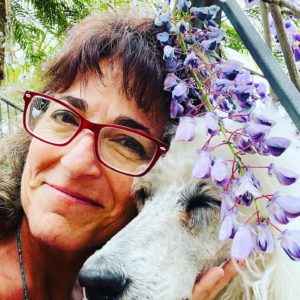By Elinor Silverstein, GCFP CM
In Feldenkrais’ thinking we have a way of considering how to see things. The gentle challenge is to be able to see with our eyes and mind, and might I say, our hearts and spirits, up close and far away. And sometimes both at the same time. We call it micro and macro zooming. Moshe Feldenkrias smiled when he said he believed this helped us to keep an open mind in our environment around us. I like having an open mind, it assuages most anxiety weeds from growing in my own mind-landscape.
I love to be in nature for all she shares with us. And when I am in my garden, she draws my eyes up close to see a flower, then up and far away to scan the garden and hillside. I am thankful to remind myself by seeing something close, and looking up to the distance and one side to the other, and back up close again, I am giving myself a gift of more fully enjoying all that is around me.
It is something I learned from my ecology professor while out hiking and tracking wild animal prints. It would help us see footprints, broken twigs, and moved brush, then far away from us to follow their sounds and movement, and side to side. In Feldenkrais’ thinking we know the importance of lateral eye movement and healthy aging brain function.
I had a painting instructor who also taught this. He would say, “The human eye sees up close and then naturally scans one side to the other out at a distance and back to the front.” He added, “This is what makes the painting interesting. Otherwise, just take a photo.”
For decades, neuroscientists have known that the average onlooker sees in front of them then moves their gaze to the distance, and to the left, then to the right. Even if they don’t actually scan their eyes, their brain sees it first. I love seeing this concept used in marketing, too. Could it be called the neuroscience of marketing? Studies and research have shown that we are attracted to colors, shapes and perceived movement. Some colors are stimulating and wake us up, while others are calming and can give us a sense of rest and relaxation. Then there are the soft and sharp color contrasts and what they do with our nervous system. The science girl in me smiles, but let’s get back to gardening and our relationship to it.
When we walk into a garden, we might see what is up close and in front of us, but a seasoned gardener knows how our eyes and senses guide us also out to the distance and out to the sides and back, and therefore creates their color and texture palette from there. This is how we create an interesting landscape for the visitor and for ourselves.
I have many entrances to my own garden and love playing from each opening. One entrance is greeted by the soft large pillows of pink iceberg roses in front of the visitor, welcoming almost like a soft, gentle happy hug. Then as you look up and far away, your eyes will see washes of more pink roses on the hillside, along with lavender sweetpeas. There is a deep watermelon-pink crepe myrtle tree that pops up like a fountain of fireworks. What a joy.
If that isn’t enough, this view invites you to open your curiosity for more, to see light and dark pink flowers on the Anna Apple tree, along with our other large old apple tree. As you start to purposely look further to the left and downward, you will see with great anticipation a huge splash of dark pink, almost red, climbing rose that covers most of a seven foot tall wall. It reaches out to your eyes to look gently further to your left and right, bringing in both the distance and closeup of variations of pink flowers of all sorts, with a sprinkle of lavender and light purple.
It is then that you might decide to rest yourself. Take in a breath, smell the air, and rest some more. Then start the process all over again. What a gentle sigh of relief, comfort and peace we can feel opening our senses more fully in nature, no matter how large or small our garden in life is.
In this warm welcoming of nature, invite yourself to open all your senses like your eyes for light, colors, shapes, and textures.
Listen to sounds in nature like birds, as my dear Mommaleh would say, “Look and listen to the breeze between the leaves. It is where you will find me. It is where you will hear the voices in the Universe talk to you. It is always talking, just a matter of whether you are listening.”
I find so much solace and peace in nature and the garden.
When you open your senses, move your body, feel the soil between your fingers, notice how you feel. Is there a sense of quietness, peace, relief? We all need something that is free to give us this sense of freedom in our body, mind and soul. Remember, nature is everywhere. It is up to us to see it, sense it, and experience its greatness in all its large and smallness. Upclose and far away, and sometimes both at the same time.
Enjoy Elinor’s eye movement lesson that will help improve your vision, hearing, and even ability to smell.
About Elinor:
 Elinor Silverstein, an internationally recognized Guild Certified Feldenkrais Practitioner, holds degrees in Biology and Zoology. In addition, she integrates the sciences of nutrition and movement biology into her teaching of the Gut-Brain Connection and Vagus Nerve System Health.
Elinor Silverstein, an internationally recognized Guild Certified Feldenkrais Practitioner, holds degrees in Biology and Zoology. In addition, she integrates the sciences of nutrition and movement biology into her teaching of the Gut-Brain Connection and Vagus Nerve System Health.

